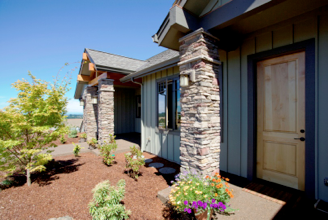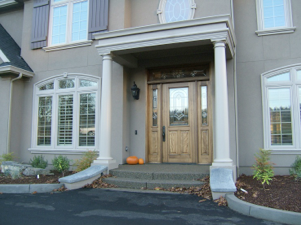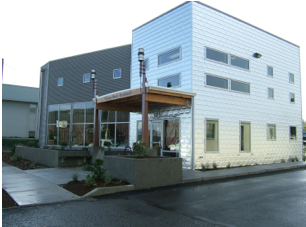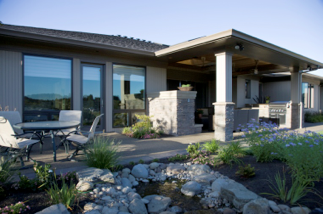[vc_row][vc_column width=”1/3″][vc_single_image image=”1319″ css_animation=”left-to-right” img_link_target=”_self” img_size=”full”][dt_gap height=”20″][/vc_column][vc_column width=”2/3″][vc_column_text]
Choosing the Best Siding for Your Custom Home
Over the years Kaufman Homes has used many different kinds of siding depending on Customer request, types of applications, desired home style and for economic reasons. Past experience has shown that some siding’s can be problems such as LP siding back in 80’s and 90’s. Kaufman works really hard at analyzing new products and the potential problems that may exist.
Fiber Cement Siding
Fiber cement siding comes in an array of textures that give the appearance of actual types of wood. It is more durable than wood since it is termite-resistant, water-resistant, non-flammable, and guaranteed to last 50 years (depending on the manufacturer). Fiber cement siding is composed of cement, sand or fly ash, and cellulose fiber. You will find that fiber cement siding is typically more expensive than vinyl but less than wood siding. It is installed over exterior wall sheathing on building paper or weather resistive barrier. Factory painting is available and generally warranted for 25 years.
Although more expensive than vinyl, fiber cement siding is considerably less expensive than wood. Fiber cement siding has become popular because it requires little maintenance and can have a natural, wood-like appearance.
If you want the look of authentic wood with a bit less maintenance, fiber cement is a good option.

Wood Siding
Modern science has given us many synthetic wood-look products, and yet solid wood remain favorite choices for finer custom homes. With periodic care, wood siding will outlast vinyl and other pretenders. Many wood frame houses built centuries ago still look beautiful today.
Wood Siding: Bevel Siding
Bevel (also called clapboard or lap) siding is one of the oldest forms of exterior cladding used on homes. Pine, spruce, cypress, and Douglas fir are the favorites because of their longevity and price. Cedar and redwood are great options, as they contain natural rot resistance, but will cost more.
Bevel siding is installed horizontally with the upper piece overlapping the lower. Wood siding is installed over a solid surface such as plywood with building paper or weather resistant barrier and a finishing coat (paint or stain) and caulking on the outside. All wood siding requires ongoing maintenance including painting and caulking to prevent weather damage.
Wood Siding: Shakes and Shingles
Shakes are machine- or hand-sawn from wooden blocks called bolts. Shakes are thicker than shingles and less uniform in appearance and thickness, but they do last longer. Wood shingles are sawn for a smooth and consistent look and can be cut into an array of shapes to create visual interest. Both come from a variety of woods but most common are Western red cedar and redwood.
Shakes and shingles are available with a fire-retardant treatment, which is a requirement in high-risk locations. They are installed over a solid surface such as plywood with a moisture barrier between the two and a finishing coat (paint or stain) and caulking on the outside. Shake and shingle siding require periodic maintenance including painting and caulking to prevent weather damage.
Wood Siding: Board and Batten
Board-and-batten siding is an American classic that has been used since our nation’s early days. Board-and-batten, sometimes referred to as barn siding, is a vertical design created by using wide boards, such as cedar or pine, spaced with narrower strips, the battens, covering the places where the wide boards come together. There are no standard board or batten widths or spacings, so feel free to innovate. This siding can be installed directly over a flat surface such as plywood with building paper or weather resistive barrier. Wide boards are placed first and then battens are used to cover the spaces between the boards.
Wood Siding: Plank Style
Planks for this type of siding can be cut perfectly rectangular, tapered or with special milled cuts. The special milled cuts are: V-Groove, channel, rabbeted bevel, shiplap, and drop. In addition to providing somewhat of a texture, special milled cuts also fit together in such a way as to protect joints from water infiltration.
Engineered Wood Siding
Engineered wood siding, or composite wood, is made with wood castoffs, such as sawdust, and bonding agents. It is a strong, lightweight product that is less expensive than real wood. Oriented strand board (OSB), hardboard, and veneered plywood are examples of engineered wood products. Engineered wood comes in an array of typical wood siding styles and factory applied finishes are available. The standard life expectancy, if installed properly and maintained, is about 20-30 years.
Engineered wood cuts, handles, and is applied like solid-wood siding, but you do not have the imperfections that often accompany and must be negotiated with in real wood. Because the textured grain is uniform, engineered wood does not look exactly like real wood. Still, the appearance is more natural than vinyl or aluminum.
Stucco Siding

With the reasonable costs of stucco, its variety of applications, and the untold numbers of recipes for making it, stucco as a siding has been in use for hundreds of years.
Because it can be shaped and textured, stucco is used to achieve an array of architectural styles. Traditional stucco is cement combined with water and inert materials such as sand and lime.
Stucco is very similar to plaster on an interior wall. Today some stucco has an acrylic finish. In a traditional stucco application, galvanized metal screening is attached to the sheathing and studs of the house. Two or three coats of various stucco mixtures are then applied over the metal screening. Finally, the top coat of a stucco siding is applied with a smooth or textured finish.
Synthetic Stucco
Many custom homes built after the 1950s use a variety of synthetic materials that resemble stucco. Mock stucco siding is often composed of foam insulation board or cement panels secured to the walls. Although synthetic stucco may look authentic, real stucco tends to be heavier. Walls made of genuine stucco sound solid when tapped and will be less likely to suffer damage from a hard blow. Also, genuine stucco holds up well in wet conditions. Although it is porous and will absorb moisture, genuine stucco will dry easily, without damage to the structure.
One type of synthetic stucco, known as EIFS (Exterior Insulation and Finish Systems), has been associated with moisture problems. The underlying wood on EIFS sided homes may suffer rot damage. This type of siding system is not recommended for use in the Northwest.
While metals are regularly used as roofing and structural materials, metal siding on custom homes is becoming more common thanks to an increasing number of sources for material.

Whether the metal is copper, zinc, aluminum, or one of the various types of steel, the beauty of metals is the degree to which they can be formed to meet required shapes, curves, and edges. Thestrength and the longevity of metals also surpass most of the common siding materials currently on the market.
The application process generally requires a frame to attach it to, a backing material such as plywood, and a moisture barrier (these needs will vary depending on the specific material and the location of the house). The surface of metals such as copper and Corten steel will change when exposed to weather, but most will maintain the factory finish indefinitely. Prefinished painted finishes have been known to fade, chalk and runoff onto brick walls often below the siding. Newer vinyl coated finishes are available and alleviate past paint problems, but are expensive.
Aluminum is easy to maintain and fairly durable, although it can dent and fade, aluminum is fireproof and is not usually considered harmful to your health or the environment.
Vinyl Siding
Since its introduction in the 1960s, vinyl has become the No. 1 siding in the United States because of low cost, versatility, and low maintenance. Hundreds of color choices are available in profiles that include horizontal and vertical panels, shakes, shingles, fish scales, lap, and beaded designs. The only routine maintenance is an occasional wash. Advertisements often imply that vinyl siding is permanent. It is true that vinyl will last a very long time. (That’s why it is so difficult to dispose of safely.) In extreme weather, however, vinyl is less durable than wood and masonry. Violent wind can get underneath the thin sheets of vinyl siding and lift a panel from the wall. Windblown debris can puncture vinyl. New developments are making vinyl is stronger and less brittle, but the plastic sheets will still crack or break if struck by a lawnmower. Since vinyl and its accessories will melt when exposed to significant fire or flame, owners of vinyl siding should take care to keep grills and combustible materials, such as mulch and dry leaves, away from the siding. Damage cannot be patched; you will need to replace a panel. Vinyl is made from a PVC (polyvinyl chloride) plastic resin that is thought to cause cancer in humans. Although vinyl may be safe while it is on your home, some scientists believe that manufacturing and disposing vinyl is hazardous to our health and to the environment. Accidental fires in vinyl-sided buildings are more dangerous because vinyl produces toxic fumes when heated. In addition, doctors are reporting a high incidence of neurological damage, respiratory problems, liver and kidney failure, birth defects, and cancer among people who work in or live near factories where vinyl is produced.
Hopefully this information is helpful if you are considering building a custom home, as you can see the siding choices are numerous; or you have an existing home and wish to maintain the siding and want to keep the exterior looking good. As always, Kaufman Homes is available to help with all your housing needs.[/vc_column_text][dt_gap height=”10″][/vc_column][/vc_row]


